Pruning roses in spring: rules, tips, recommendations
Each grower in the vast and diverse kingdom of his wards has his own preferences and favorites. But it is also indisputable that the rose is unanimously recognized as the queen of flowers. Magnificent and bright, tender and shy, fragrant and blooming profusely - from year to year it moves further and further north, winning hearts and decorating garden plots with its regal appearance. Of course, this becomes possible thanks to climate change and breeding work to breed winter-hardy varieties. But without the painstaking and everyday work of gardeners - enthusiasts, the flower queen would feel very uncomfortable here. Let's talk about one of the most important aspects of spring care - pruning roses.
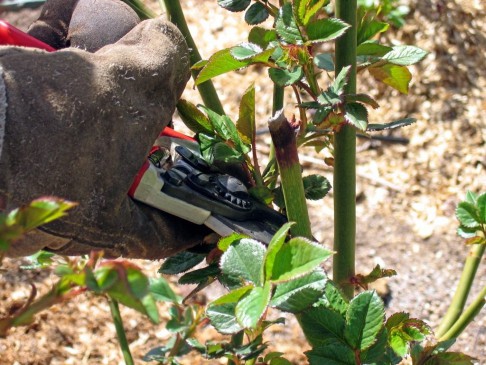
Content
- 1 Why prune roses in spring: advantages and disadvantages of spring pruning
- 2 When to prune roses in spring: timing for spring pruning
- 3 General rules and tips for spring pruning roses
- 4 Instructions for pruning roses depending on the variety (climbing, bush and others)
- 5 Caring for roses after spring pruning
Why prune roses in spring: advantages and disadvantages of spring pruning
All work on the care of roses begins in early spring, even before the onset of the growing season. Experienced flower growers consider spring pruning of bushes to be the main shaping and caring action. This is a rather time-consuming and responsible process, because the state and growth of the plant depends on its successful completion:
- Pruning roses in spring allows you to clear the bush of old, diseased and damaged branches.
- The plant rejuvenates at the beginning of the new season after the correct procedure.
- In the spring, while the plant has not yet woken up, it is more convenient to form the required shape of the bush.
- After pruning in spring, the rose begins the growing season more actively and gives a large green mass.
- There is an active formation of flower buds, and the total duration of flowering of the bush in summer also increases.
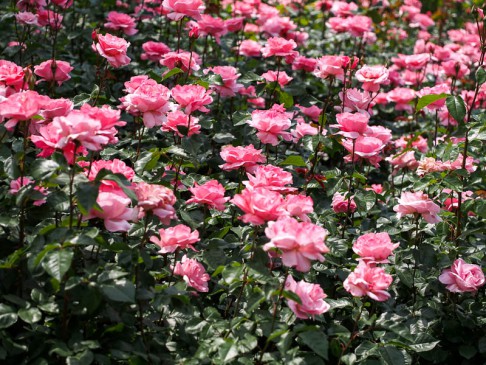
In order not to harm the queen of flowers, it is necessary to thoroughly study the pruning procedure, as well as calculate the timing of its implementation. Indeed, in addition to the obvious advantages, spring pruning also has some negative aspects that it is desirable to keep in mind.
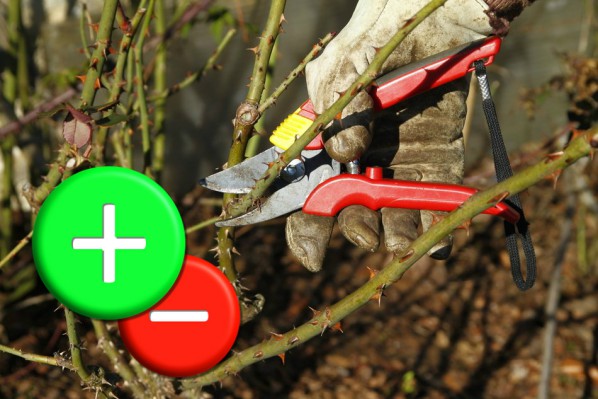
Spring Pruning Benefits:
- Since the plant has already overwintered, it is possible to assess the extent of its damage and properly clean it of old branches.
- The coincidence of the procedure with the beginning of the growing season helps to quickly tighten the sections and reduce the possibility of infection.
Disadvantages of pruning in spring:
- Pruning too early can cause frost damage to the rose - this will slow down development, reducing flowering.
- If the pruning time is delayed, the plant will spend extra energy on awakening sick and dying shoots - this will negatively affect the general condition of the rose.
When to prune roses in spring: timing for spring pruning
The beginning of spring pruning depends on the weather conditions of the particular area. When the warm year is stable, from rose bushes you can remove the material covering them and carefully examine the plants for winter damage... When the buds begin to awaken at the base of the stems, the pruning procedure can begin. The main thing is not to miss the moment when shoots begin to form, because the rose will spend precious energy on their growth.
In regions with a warm and temperate climate, the time for pruning roses in spring is in March or early April. In more northern areas, where snow melts much later and the soil warms up more slowly, it is advisable to postpone spring pruning until mid-late April.
Note! Pruning roses must be completed before the beginning of summer, otherwise the new shoots will not have time to complete their development before winter and will freeze out.
General rules and tips for spring pruning roses
Novice gardeners are afraid to harm their plants, considering pruning rose bushes a difficult task for beginners. Of course, the queen of flowers is a capricious plant that requires careful attention and special care. But subject to certain rules, a beginner can also cope with pruning rose bushes.

For each group of roses there is a specific pruning system, but you can also distinguish some general tips for this procedure:
- It is always necessary to start spring rose care from the removal of covering materialscleaning the soil under the bushes and inspection of the plant itself for general condition.
- After inspection, all old, diseased and frozen branches, as well as side shoots facing the inside of the bush, are cut out to thin out and form a beautiful silhouette.
- Pruning is always done with a sharp pruner to prevent damage to the bark or the formation of cracks in the trunk. In places of such damage, fungal infections can occur, which threatens the weakening or death of the plant. Diseased shoots are removed to the healthy part, that is, to the green trunk and white core.
- All gardening equipment must be disinfected with a dark solution of potassium permanganate before the procedure.
- All cuts are made obliquely so that rain or irrigation water does not linger in the disturbed place, and decay cannot develop.
- Shoots are cut 0.5 cm above the healthy swollen bud, directed from the middle of the bush, in order to prevent dense growth in the center of the plant. One-year shoots retain up to 5 buds. On adult trunks, several healthy lateral branches with 2-3 buds on each are preserved. Be sure to pay attention to the strength of the shoots: in the weakened, 1 bud is preserved, in the strong - 3-5 buds.
- After the end of the pruning of each bush, the sections are closed with garden pitch, and the plant itself is treated with a solution of copper sulfate in order to prevent diseases.
- If wild growth begins to grow on the grafted bushes, which is distinguished by a light green color, then it is immediately cut out under the base. If this condition is not met, the plant will spend a lot of energy on uncultivated shoots, and the contour of the bush will be disturbed and thicken - the rose will lose its appearance and weaken.
Depending on the time of pruning, its goals and degree, there are several types and types of this procedure for caring for roses.
Trim types by time
Pruning of plants can be carried out during the entire vegetative period, therefore, there are several types of it:
- Spring - the main annual pruning is applied to all garden groups and varieties of roses. The goal is rejuvenation and care.
- Summer - produced as needed. The goal is to maintain the shape of the bush and extend the flowering period.
- Autumn - used for cold climatic regions. The goal is to form bushes for optimal cover.
Detailed information about how to care for a plant in autumn and carry out autumn pruning, can be read in this article.
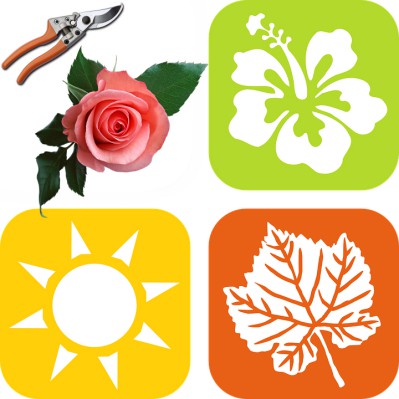
Types of pruning by its degree
Each plant can be pruned to a different height and density. This leads to the division of this trim into the following types:
- Strong - used mainly for planting young plantsand also as a rejuvenation of age bushes. It consists in low pruning for 3-4 buds (approximately 15 cm above the ground).
- Medium to moderate - used to accelerate the beginning of flowering. The stems are cut not below the 5th bud, but optimally at the 7th bud.
- Easy - is not done too often so that the bushes do not stretch out. The shoot is left with 8-12 buds.
Typically a combination of pruning types is used to achieve continuous flowering and beautiful plant appearance.
Types of trimming by target
Each pruning of rose bushes pursues specific goals, so growers distinguish four types of this operation:
- Sanitary (preventive) - produced immediately after harvesting the material that covered roses in winter... It consists in cutting off diseased and frozen stems under the base, and leaving damaged shoots at the height of a healthy bud. In addition, it is required to cut the weakened stems if it does not harm the plant.
- Thinning - includes cutting out weak and old shoots, pruning side branches growing deeper into the bush and destroying wild shoots. Branches that did not bloom in the previous season are given a second chance by pruning to a swollen bud. This procedure is advisable in the spring.
- Anti-aging - intended for bushes over 3 years old and carried out in the spring.
Worth knowing! Every year, a rose bush gives a strong shoot from the base with an equally powerful root (regenerating shoot) - it serves as a replacement for old branches and is responsible for the longevity of the plant.
- Anti-aging pruning consists in clearing space for regeneration shoots by partially removing old branches and trimming the remaining branches up to 20 cm above the ground.
- Simplified - invention of flower growers in recent years. It consists in cleaning the bush from dried branches and pruning the remaining shoots to half their height. It has been noticed that this manipulation produces very large buds.
Video: general rules for pruning roses in spring, summer and autumn
Instructions for pruning roses depending on the variety (climbing, bush and others)
Pruning rose bushes regularly and in accordance with existing rules and regulations provides the plant with a comfortable environment, which prolongs the life of the flower queen. In addition, after the procedure, the bush acquires an optimal shape and responds to care with long and abundant flowering. Pruning roses is possible at any time of the growing season, but it is better to carry out cardinal changes in the spring, when the plant has not yet had time to fully wake up. In addition to the general rules of manipulation, there are special techniques for each variety of roses.
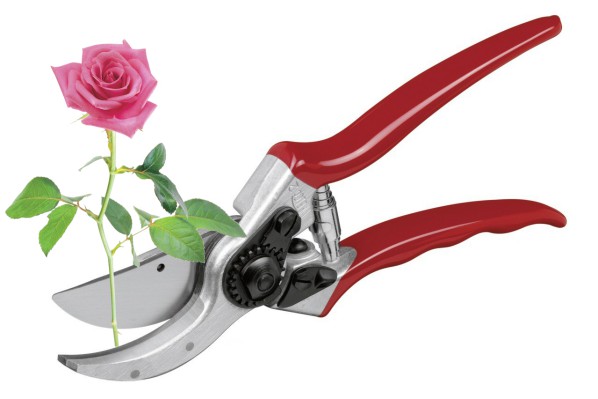
Climbing or curly roses
The peculiarities of this variety include thin branches intertwining with each other and with neighboring plants. When pruning, they must be handled very carefully. Another distinctive feature of climbing roses is considered to be their one-time flowering. This means that during the procedure for pruning climbing roses, you need to take special care of the recovery shoots - the stronger they are, the more profuse the next year will bloom.
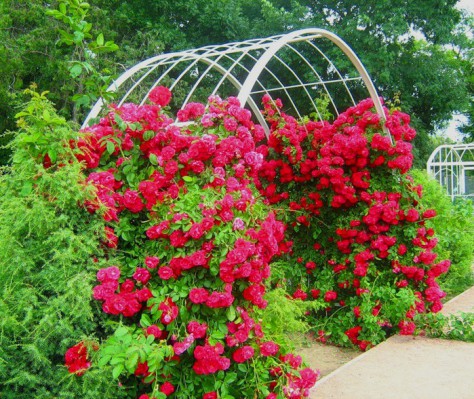
For climbing roses, light pruning is used and act as follows:
- With the establishment of warm weather remove the covering material and carry out preventive pruning, that is, remove dead stems.
- Assess the degree of density of the bush. It is not necessary to prune this variety. But when the branches grow uncontrollably, the appearance of the plant will deteriorate, flowering will occur later and weaker. In addition, dense branches will lead to poor ventilation of the bush and infection with powdery mildew. And in the fall, it will be impossible to properly cover such a plant. Therefore, the procedure should be carried out in order to form a plant.
- Start pruning climbing roses in spring. The main branches are shortened to the first healthy bud. Extra long branches can be shortened for a nice silhouette. The lateral branches are cut, leaving the lower part with 2-3 buds.
- All branches growing on the inside of the main stems must be cut to form a neat plant.
Scheme of spring pruning of climbing roses:
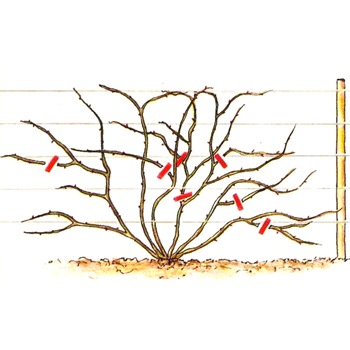
The peculiarity of pruning climbing roses is that they begin to cut the bush from the outside and only then proceed to the inner shoots, otherwise they will not get close to them.
Video: how and with what tools to cut a climbing rose
Bush roses
All bush roses cannot be cut too much. The purpose of this procedure is to form the original silhouette of the plant. The size is chosen according to the taste of the grower. These can be neat small balls (no higher than 30 cm) or bushes with a crown up to 1 meter or more. Ideally, a bush will be formed in the form of a dome with an empty center. This structure is more permeable to water and less prone to decay.
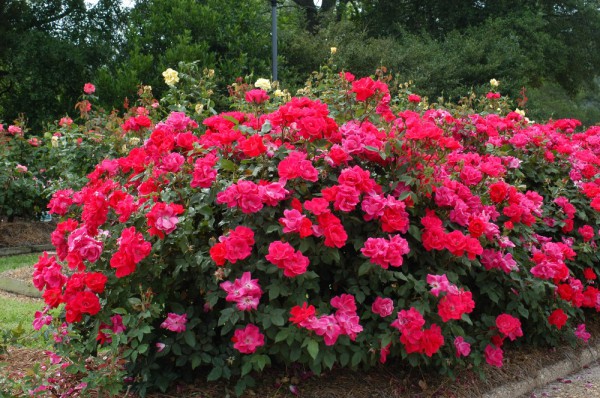
Spring work on pruning bush roses consists of a few steps:
- The covering material is removed, after which preventive cleaning is required. Eliminate frozen, dry shoots.
- If you create a small neat bush, then the young main stems are shortened by the first upper healthy bud.
- To obtain a lush crown, the stem is cut along with the first upper bud. Then the next buds wake up and add additional volume to the bush.
- All shoots directed inside the bush are cut off so that there is no interlacing of branches and loss of a neat appearance.
A feature of spray roses is the formation of several inflorescences on one shoot. And the task of spring pruning of roses is to form a beautiful silhouette and lay as many buds as possible.
Scheme for pruning spray roses:
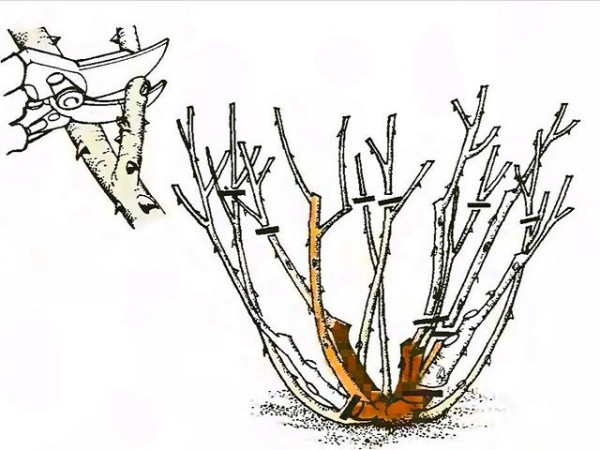
Hybrid tea roses
Flowers in this variety appear on young shoots, and their vigorous growth is facilitated by a moderate type of pruning carried out every spring. At the same time, old branches are no longer able to bloom, and strong pruning is used to remove them.
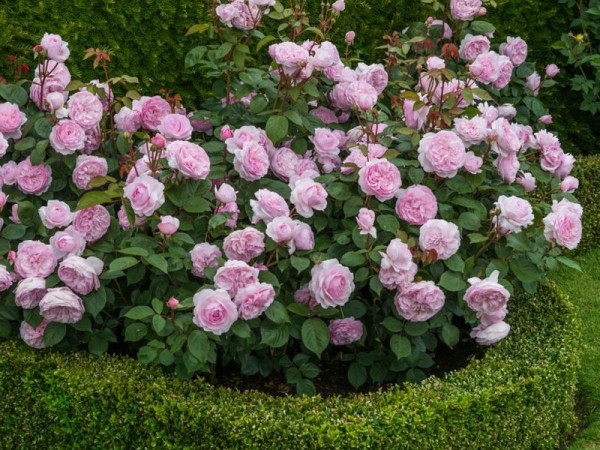
When pruning hybrid tea roses in spring, 5-7 last year's stems are left, because it is not known how many young shoots the rose will give this year. The more powerful the stem, the more buds are left on it. Ideally, leave a column about 15 cm high (on average 5 buds).
The peculiarity of pruning hybrid tea roses in spring is the use of a combined method.
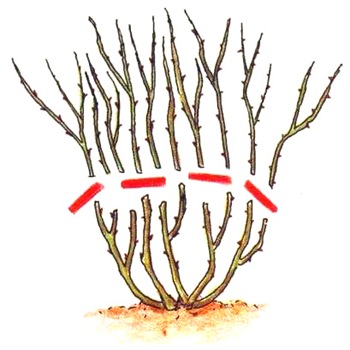
Video: pruning hybrid tea roses in spring
Floribunda
For this variety, the combined process of pruning roses is optimal: individual shoots are cut strongly, and the rest are moderately cut. This results in massive shoot growth and two waves of flowering. But the first thing to do in the spring is preventive cleaning and removal of shoots facing the center of the bush.
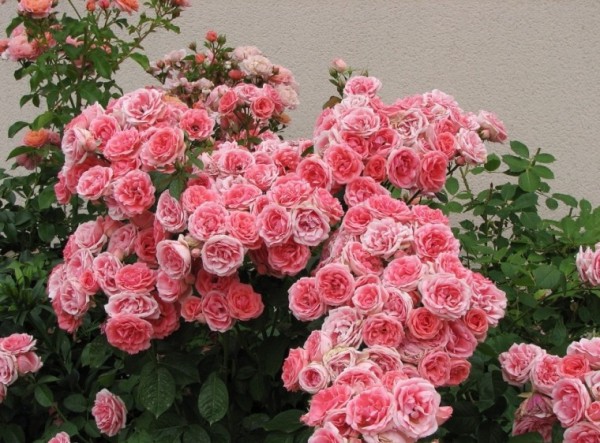
Last year's shoots are left 2/3 of the length, up to 3 buds are cut off on the main stems. Old branches are subjected to a strong kind of pruning.
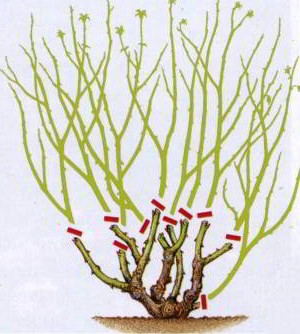
Video: spring pruning floribunda and English roses
Caring for roses after spring pruning
Spring pruning of roses is a serious test for the queen of flowers. Therefore, to reduce serious consequences after the procedure, it is necessary to calm the plant:
- Improve soil aeration and carry out preventive spraying with copper sulfate.
- Before awakening the leaves, feed the bushes.
Note! The site already has a detailed article about how to feed roses in spring and summer for lush bloom.
- Watering during the beginning of the growing season is especially necessary. Abundant watering is carried out once a week, after which the soil is loosened.
- Immediately after manipulation, it is necessary to mulch the soil. For this purpose, peat and humus are used. Continuous repetition of mulching reduces watering.
By the way! Mulch increases soil aeration and retains nutrients in it.
- After a week, carry out chemical treatment of plants against diseases and pests.
Video: the secrets of caring for roses in spring and pruning
The queen of flowers is not only capricious, but also a very grateful plant. She will respond to love and care according to all norms and rules with active growth and long, abundant flowering. The rose will decorate the garden area with its regal splendor and fill the air with a divine scent. All that is needed for this is to properly prune the roses in the spring.

